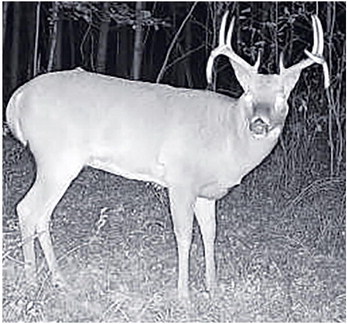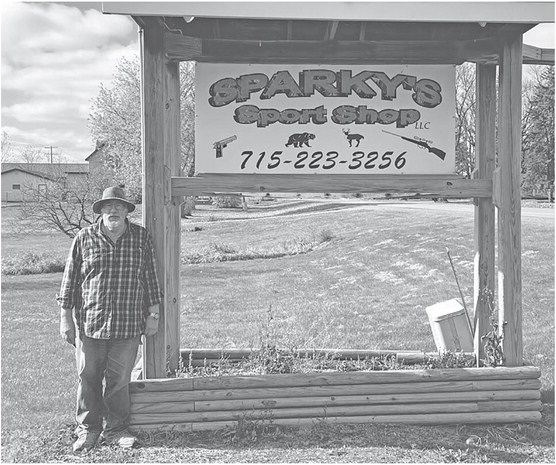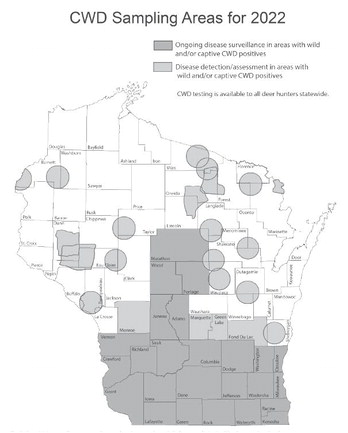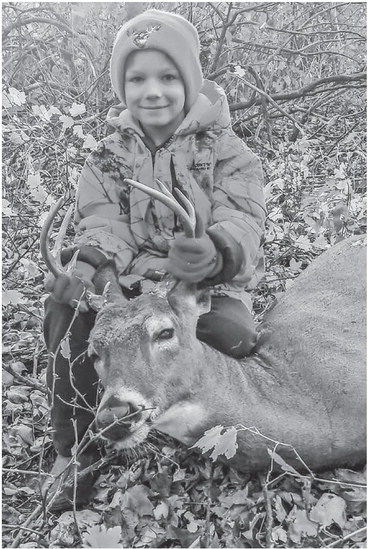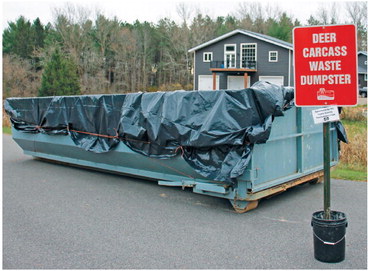Harvests expected to trend upward in most locales during 9-day hunt
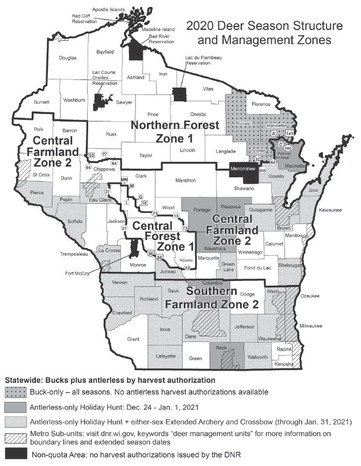

BY MATT FREY
THE STAR NEWS
November has arrived in Wisconsin and with it comes the anticipation of another hunt for white-tailed.
Many state hunters have already added venison to the freezer or placed orders at their taxidermists this fall following successful bow or youth hunts. Early November, of course, draws the attention of many archery and crossbow hunters who are hunting the deer’s mating season, “the rut,” when chances for catching a less wary trophy buck increase.
Next week, the focus turns to the nineday firearms hunt, set for Nov. 21-29. How deer populations sit will depend on where you hunt. One thing the Wisconsin Department of Natural Resources is pretty sure of, is that hunters won’t be alone in their pursuit in 2020.
“Our assumption based on other outdoor recreation activities this year is that there are probably going to be more hunters out and about,” said Josh Spiegel, the DNR’s wildlife biologist for Taylor, Rusk and Sawyer counties in an Oct. 30 interview. “With the COVID situation issues and people potentially still being laid off or being put on quarantine, they might slip away by themselves into the woods. We suspect that our hunter numbers will increase as well. It should at least remain stable even I think with poor weather I think hunters will want to get out and do stuff. That’s been the trend we’ve been seeing this year in general, through turkey season and fishing and our fall hunting seasons.”
Through mid-fall, Spiegel said DNR was reporting a 15% increase in crossbow and archery sales over the same time last year, an 11% increase in gun deer licenses and a 6% increase in conservation patron licenses.
Generally speaking, deer numbers are believed to be strong in central and most of northern Wisconsin and bounce-back harvest totals are expected after a significant drop last year in the nine-day gun harvest. Two likely factors in that drop were two major snowstorms that hampered the last five days of the season and the Nov. 23 start date, which meant most rutting activity was complete and deer movement was likely low in many areas on opening weekend.
Here is a forecast synopsis for the four-county Central Wisconsin News coverage area.
Taylor County
Spiegel said he expects a solid hunt this November in Taylor County if the weather cooperates, which it seemed on pace to do in the early portion of the month when the rut should’ve hit its peak and after a cold snap finally moved out of Wisconsin.
“They’re calling for cold temps at night and warming up to high 30s and 40s and into the 50s, so deer should really be active,” he said at the time. “Compared to last year, we had days in the rut that it was 15 or even low teens at night. Midday highs were about 25. That was miserable from a hunting standpoint. The deer were spotty and rutting activity was delayed. It looks like it should be pretty hot and heavy this year.”
Last year’s low harvest likely kept more deer on the landscape than expected heading into winter, but fortunately a mild winter should’ve helped the deer herd throughout the county.
“All of our indicators and our late summer/early fall observation periods show a lot of does, a lot of fawns,” Spie- gel said. “Antler development looks really nice on bucks for the most part. There are some spotty areas north of Taylor County, there’s that snow belt where there’s some winter impact. But for most of northcentral Wisconsin and our area, the deer came out of winter in really good shape. Does’ production was very good this summer. We should see an increase in the younger population and with the deer coming out of winter with good health the antler development for bucks has been very solid. Mature bucks should have nice racks. The younger deer should look pretty decent so we’re pretty hopeful that we’re keyed up for a decent season, even with opening day being a touch on the later side.”
Taylor County’s Deer Advisory Council has been working under a three-year increase objective, but that increase focus –– which is in its last year –– has been primarily on the county’s public lands. Anterless authorizations were bumped up to 1,000 on public land this year over last year’s 675. Officials are aiming to get more aggressive on private-land harvests to keep those populations from becoming unmanageable and offered 8,350 antlerless permits on those lands, up from 5,600 last year. As of Nov. 4, 1,388 were still available for purchase.
Bow and crossbow hunters did well in Taylor County in 2019. The crossbow harvest went from 1,084 deer in 2018 to 1,139 in 2019, while archery hunters tagged 550 deer, compared to 596 in 2018.
As noted earlier, it was the gun hunt where numbers took a 23% overall decrease from 4,026 deer in 2018 to 3,112.
As of Nov. 3, DNR statistics showed hunters in Taylor County had filled 418 archery tags, with 219 on them being on adult bucks, and 1,012 crossbow tags, including 535 bucks. Also of note in Taylor County, this is year two of an increased effort on chronic wasting disease surveillance. Hunters are urged to submit their deer heads for testing at one of four self-serve kiosks in the county. Carcass waste also may be dropped off at dumpster sites that will be available during the gun season at the DNR’s Medford Ranger Station and the Rib Lake Cenex station. Those two sites will have self-serve kiosks, along with the Gilman Corner Store and the Northwoods Country Store in Sheldon.
Marathon County
In the state’s largest county, Marathon County, the objective for DNR officials and those serving on the County Deer Advisory Council is to maintain the county’s solid overall deer population. But to do that, they are counting on hunters to be willing to harvest antlerless deer.
As in recent seasons, one free farmland authorization went to every license buyer who wanted one this fall in Marathon County, which is how the vast majority of antlerless permits are issued in the county. Just like last year, an additional 2,000 private-land tags were made available for purchase. As of Nov. 4, just 61 private-land authorizations were still available. Also, the county again offered no bonus public-land authorizations this year, but does can be shot on public lands using the farmland tags.
The goal this year, just like 2019, is to harvest 7,000 antlerless deer in the county. Marathon County hunters were on a good pace through the crossbow/archery season. But, like much of the state, the nine-day gun hunt did not produce the anticipated harvest and 5,221 antlerless deer wound up being harvested through all 2019 seasons for a success rate of just 11.8% on more than 35,000 issued tags.
If hunters can reach the antlerless quota of 7,000, a population increase of 1% is expected which meets the criteria for the CDAC’s “maintain” objective.
In the DNR’s 2020 Deer Fall Forecast, Marathon County wildlife biologist Brandon Stefanski said staff and citizen observations indicate fawn production was solid after the mild winter of 2019-20.
“The lower than expected harvest during the 2019 gun season suggests that more deer will be available in 2020, including adult bucks,” Stefanski said.
In 2019, Marathon County’s archery harvest was up slightly from the previous year, going from 1,261 deer to 1,284. The crossbow harvest went up to 1,891 from 1,758. But the gun harvest took a steep drop from 8,759 in 2018 to 6,775 in 2019.
Through Nov. 3 of this year, according to DNR statistics, Marathon County crossbow hunters had taken 791 bucks and 723 antlerless deer for a total of 1,514, while archery hunters had nabbed 466 bucks and 479 antlerless deer for a total of 945. Harvests are up significantly over this point last year by both methods.
While the vast majority of the county is covered by private land, there are also plenty of public hunting opportunities, particularly in the nine units of the Marathon County Forest, the McMillan Marsh Wildlife Area and the Mead Wildlife Area.
During CDAC meetings this past spring, council members discussed attempting to divide the county into smaller management units as a means of better managing populations in specific areas.
Clark County
In another of the state’s largest counties, Clark County, expectations are high for a solid 2020 gun deer hunt. However, being a large county with diverse habitats means not all huntable places will have the same expectations. The county is divided into two deer management zones. Most of the land is in the Central Farmland zone, which is operated by the Clark County Deer Advisory Council under a maintain population objective. Roughly the southern third is in the Central Forest Zone, including the 135,000acre Clark County Forest. This land is under an increase population objective.
After a generally mild winter and early spring green-up, conditions seemed favorable for a stable to increasing herd population. An increasing herd population in the Central Forest portion of the county is something hunters who work those areas would most like to see. A strong antlerless harvest in 2020 probably wouldn’t hurt the higher-populated farmland areas.
“Deer numbers in the forest and farmland zones appear to be stable to slightly increasing,” DNR wildlife biologist Scott Roepke said in the DNR’s 2020 Deer Fall Forecast. Roepke covers Clark and Jackson counties. “Mild winters combined with low to moderate levels of antlerless harvest have allowed for the increase. Although it is hard to predict what mother nature will give us for the 2020 gun season, it should be an improvement over 2019. If the weather cooperates, hunters should expect an increased harvest during gun season.”
Like most areas of the state, the 2019 gun season produced significantly lower harvests in Clark County than recent years. The late start to the season, bad weather and standing crops all are receiving parts of the blame.
Clark County hunters were offered
See OUTLOOK on page 9 Outlook
Continued from page 8
one farmland antlerless authorization this year, just like 2019. The farmland zone has an antlerless harvest quota of 4,000 deer this year. There were 2,050 private-land and 50 public-land bonus authorizations offered for the farmland this year, down from 2,275 and 75 last year. Last fall, 15,738 farmland tags were issued for private lands with a success rate of 17% (2,678 filled). Success rates were even lower on public land farmland tags with only 9.6% of 4,200 tags being filled (403 deer).
Overall total harvests in 2019 for the Farmland Zone were steady, compared to the previous year. In fact, archery and crossbow harvests were both up last year. The buck gun harvest was down to 1,792 deer from 1,945 the year before, while the antlerless gun harvest dropped from 3,203 to 3,008.
In the Central Forest Zone of Clark County, the story was pretty similar. Crossbow and archery totals were up from the previous year. But the gun buck harvest dropped from 711 to 589 and the doe harvest was down from 626 to 474.
Antlerless authorization holders in the Central Forest Zone are more likely to use them. Last year’s overall success rate on those tags was 21.4% with a total of 609 antlerless deer registered in the zone, 180 on public land and 429 on private land.
So the question that should be answered in this year’s harvest numbers is was the drop in the 2019 gun harvest due to last year’s unfavorable hunting conditions in late November or were there not as many deer in the county as thought.
Through Nov. 3, hunters had registered 1,040 deer by crossbow and 531 deer by archery in the Farmland Zone of Clark County and an additional 292 deer by crossbow and 170 deer by archery in the Central Forest Zone.
As of Nov. 4, there were 544 privateland bonus tags still available in the Farmland Zone.
Chippewa County
The tone through the 2020 quotasetting and permit process in Chippewa County was to stay the course.
In the second year of a maintain population, deer harvest numbers were fairly steady in 2019. While gun harvest numbers were down –– slightly in the Central Farmland portion of the county and more significantly in the Northern Forest portion –– that was offset a bit by increased harvests by archery and crossbow hunters.
Quotas and permits levels for 2020 were set by the Chippewa County Deer Advisory Council with an eye toward keeping the population right where it is or even decreasing it by about 1%.
For the second straight year, one free farmland antlerless tag was offered with the purchase of every deer license in the county this year. One metro antlerless authorization was also available per license to be used in the metro unit surrounding Chippewa Falls.
The presence of the free farmland tags and a strong antlerless harvest in the Farmland Zone last year allowed the county CDAC to lower the harvest quota and bonus permit levels in that portion of Chippewa County. The quota is down to 1,900 compared to 4,000 last year. Privateland bonus tags were down to 2,250 from 8,275 last year and public-land bonus tags dropped to 100 after being at 1,125 last year.
About 11% of the nearly 14,000 farmland tags issued last year in Chippewa County were filled (1,528).
Overall, 4,046 deer were harvested in the county’s Farmland Zone in 2019, up from 3,912 in 2018. The antlerless harvest went up to 2,218 from 1,926 in 2018.
Antlerless authorizations went up slightly in Northern Forest zone, which makes up roughly the northern one-third of county land. The quota went from 300 last year to 675, resulting in 100 publicland tags and 2,100 private-land tags.
The Northern Forest’s overall harvest dropped from 1,130 in 2018, the first year the forest zone existed in the county, to 926 last year, mainly due to a gun harvest drop from 870 to 607. The crossbow harvest went up by 17 to 171 and the archery harvest went up by 40 from 106 to 146.
With the increase in permit levels this year, it’s expected last year’s harvest drop was more indicative of unfavorable hunting conditions during the nine-day gun hunt rather than a population drop.
As of Nov. 3 this year, Chippewa County hunters had registered 725 deer by crossbow in the Farmland Zone, with a nearly even buck/doe split. Crossbow hunters had taken an additional 168 deer out of the Northern Forest Zone with 109 of them being bucks. Archery hunters had registered 424 farmland deer (228 does) and 115 forest deer (70 bucks).
Private-land authorizations remain available in all three of Chippewa County’s deer management zones as of Nov. 4 and 89 public-land metro authorizations were unsold.
In Chippewa and Eau Claire counties, CDAC members reported many observations of bucks with good summer antler growth and does with fawns, with occasional reports of twins and triplets.

